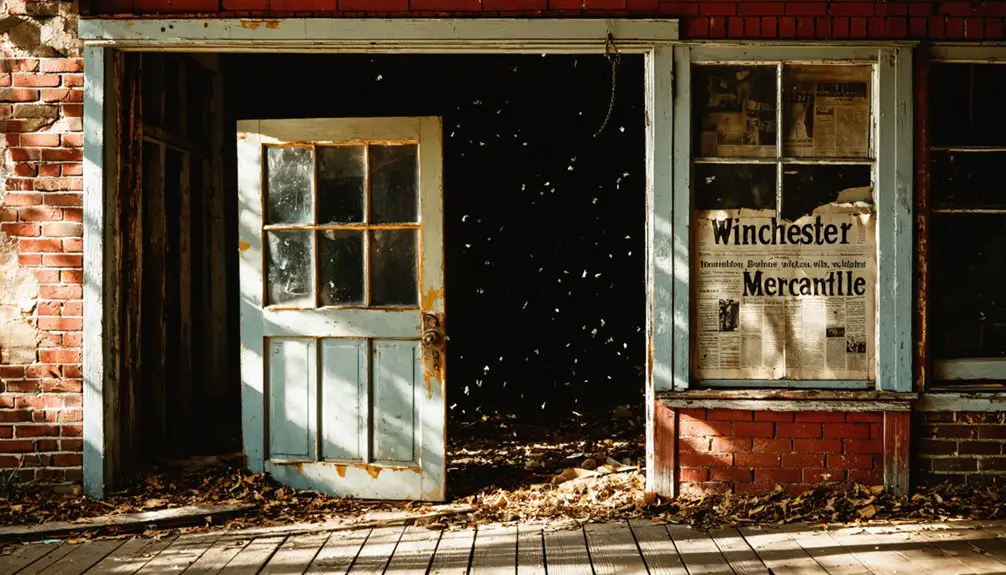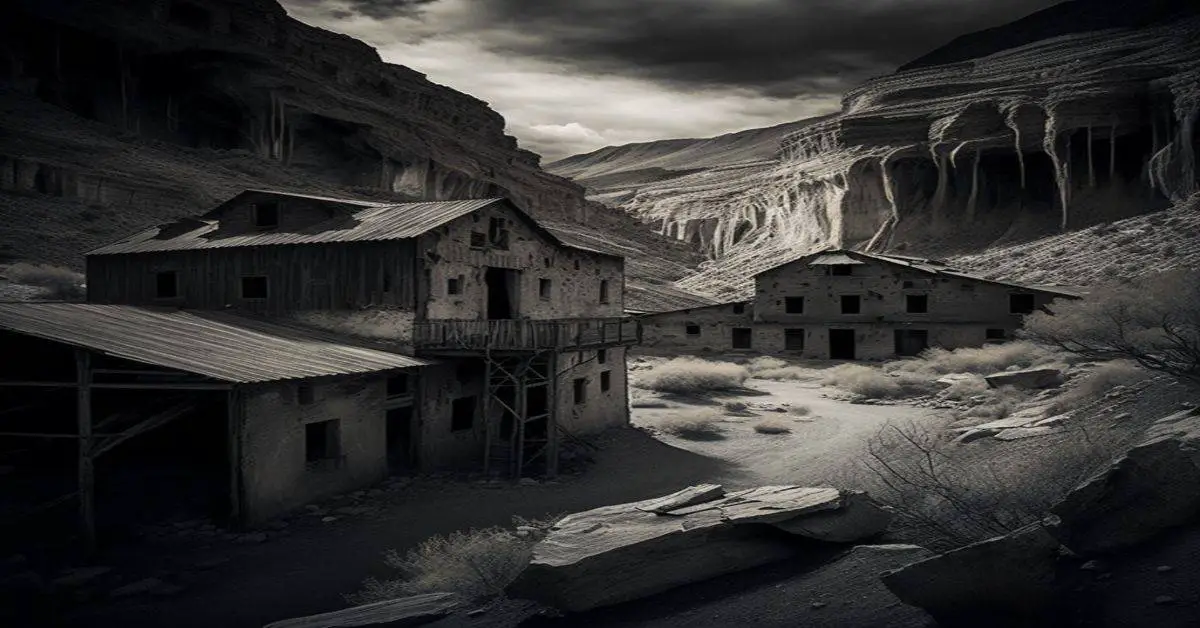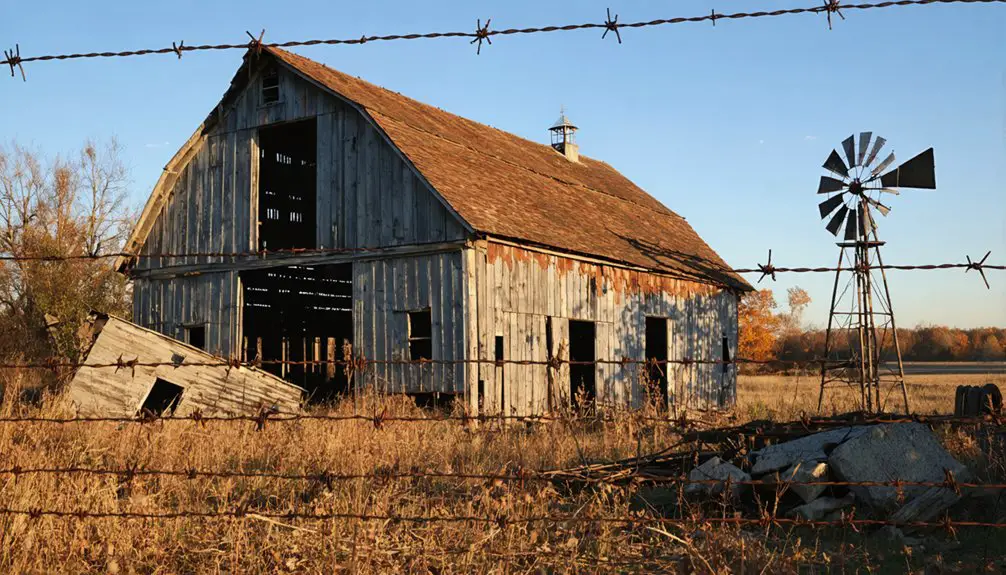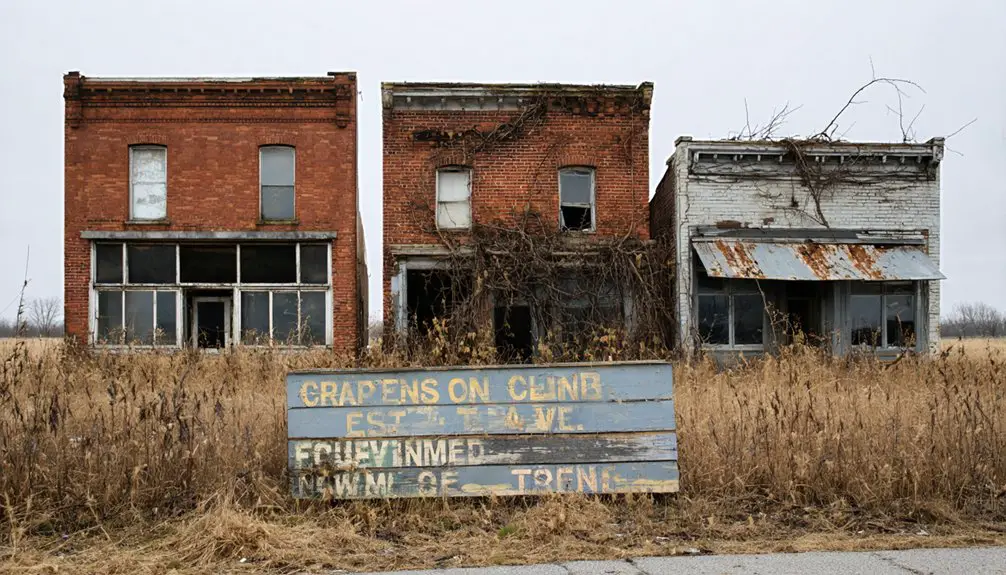You’ll find Winchester’s ghostly remains along Ohio’s Clear Fork River, where Noble Calhoun established an ambitious settlement in 1845. Despite its strategic location and careful planning, the town struggled under heavy mortgages and financial instability. Today, only scattered foundations and a few original homes mark where pioneers once farmed and traded in Richland County’s Worthington Township. Winchester’s coordinates at 40.60944°N, 82.40528°W lead to a fascinating tale of frontier dreams and challenges.
Key Takeaways
- Winchester was founded in 1845 by Noble Calhoun along Clear Fork River but failed due to severe financial difficulties and mortgage burdens.
- Located at 40.60944°N, 82.40528°W in Richland County’s Worthington Township, Winchester is now considered a ghost town.
- Economic hardships led to sheriff’s auctions, foreclosures, and fractured land ownership, causing many families to abandon the settlement.
- Only a few original structures remain today, serving as remnants of the failed pioneer settlement along Clear Fork River.
- The town’s decline contrasted with successful neighboring settlements, making it a cautionary tale of frontier development challenges.
The Birth of a Forgotten Settlement
Though many Ohio settlements flourished in the mid-1800s, Winchester’s story began with more modest ambitions. In March 1845, town founder Noble Calhoun laid out his vision for a small settlement along the Clear Fork River in Richland County’s Worthington Township.
You’ll find that Calhoun’s choice of Section 9 reflected the strategic thinking of early pioneers, seeking essential water access for the fledgling community. Unlike its English counterpart that grew from the Roman town Venta Belgarum, this Ohio settlement would have humbler origins. This stark contrast was especially evident given that the English Winchester boasted a grand Gothic cathedral stretching longer than any other in Europe.
Yet from the start, settlement challenges loomed large. While the first houses rose from the Ohio soil shortly after platting, the mortgaged land cast a shadow over Winchester’s future.
Unlike its namesake towns elsewhere in Ohio, this settlement struggled to secure the financial foundation needed for growth. The town’s early steps would prove to be its most significant, as Winchester never expanded beyond its initial cluster of homes.
Location Along the Clear Fork River
Along the gentle bends of the Clear Fork River in Richland County, Winchester carved out its brief existence at coordinates 40.60944°N, 82.40528°W.
Nestled along the Clear Fork River’s winding path, Winchester briefly claimed its spot in Richland County’s history.
You’ll find this ghost town‘s footprint south of Newville, where State Route 95 meets Hagerman Road, in Worthington Township’s fertile valley.
The settlement’s founders strategically chose this location for its crucial river access, positioning Winchester to harness the Clear Fork’s power for farming and milling operations.
The river shaped more than just the town’s economic potential – it influenced the entire layout of the community. After being platted in 1845, the town struggled financially and eventually faced a sheriff’s auction.
As part of the broader Mohican watershed, Winchester’s settlement dynamics revolved around seasonal flooding patterns and the natural flow of the waterway, which served as both a lifeline and a challenge to early residents.
Noble Calhoun’s Vision and Town Planning
You’ll find Noble Calhoun’s pioneering vision for Winchester reflected in his meticulous grid-pattern layout and strategic placement of public spaces, which aimed to create a model settlement along the Clear Fork River.
His town planning emphasized sustainable growth through careful zoning, infrastructure development, and the integration of agricultural and commercial zones near key transportation routes. Modern retailers like Walmart have adopted similar omni-channel strategies to maximize accessibility and customer convenience. Calhoun’s approach to development aligned with principles of sustainable growth that could benefit the region’s economic future.
While Calhoun’s initial planning showed promise through structured development and governance frameworks, financial challenges ultimately hindered the town’s ability to fully realize his ambitious design goals.
Initial Town Layout Plans
Noble Calhoun’s pioneering vision for Winchester emerged through meticulous planning that reflected the ambitions of early 19th-century town development.
His town design incorporated broad streets arranged in a systematic grid layout, creating an efficient framework for commerce and daily life. You’ll find he masterfully balanced the needs of residents and merchants by designating specific areas for public buildings, marketplaces, and homes.
The plan featured mixed-use zones that would’ve given you the freedom to adapt your property for various purposes.
Calhoun’s foresight included spaces for essential community gathering spots like schools and churches, while maintaining easy access to surrounding natural resources.
The streets were strategically positioned to connect with regional trade routes, ensuring Winchester’s residents could easily engage in commerce with neighboring settlements.
Financial Struggles Shape Development
Despite Calhoun’s ambitious design for Winchester, financial troubles cast a dark shadow over the town’s development from its earliest days.
You’ll find that the heavy mortgage burden on the original land crippled any chance of realizing his vision for a thriving settlement along Clear Fork River. This financial instability scared away potential investors and settlers who might’ve helped the town flourish.
While neighboring settlements like Canal Winchester prospered through strategic advantages and sound economic foundations, Winchester’s economic limitations prevented basic infrastructure development. The Ohio and Erie Canal brought vital transportation access and economic growth to Canal Winchester starting in 1831, highlighting the stark contrast between the two settlements. The Dove family settlement had become a flourishing agricultural hub during this period.
You can trace the town’s eventual abandonment directly to these early fiscal struggles. The forced sheriff’s sale of the land fractured ownership and killed any hope of coordinated growth, leaving Winchester with nothing but a few scattered homes as evidence of Calhoun’s unrealized dreams.
Financial Struggles and Eventual Decline
While Winchester showed initial promise as a settlement along the Clear Fork River, the town’s financial troubles began from its very inception. The heavily mortgaged land quickly led to a devastating sheriff’s sale, creating an atmosphere of financial instability that would plague the community’s development. Similar to Seagrove’s railroad decline, Winchester’s economic struggles ultimately led to its downfall.
You’ll find that mortgage issues and property disputes severely limited Winchester’s ability to grow beyond a few scattered homes.
- Your ancestors might’ve witnessed the heartbreaking sight of creditors reclaiming properties
- You can still sense the lost dreams of early settlers who sought prosperity here
- You’ll understand how the lack of stable land ownership drove potential investors away
- You’d recognize how these financial burdens ultimately sealed the town’s fate
Life in Early Winchester

If you’d visited Winchester in 1845, you’d have found pioneer families engaged in daily survival tasks like farming, fishing the Clear Fork River, and bartering with neighbors for essential goods.
You’d have witnessed the struggles of Noble Calhoun’s settlers as they grappled with land mortgage debts while trying to establish their homesteads in this fledgling riverside community.
The modest collection of houses along the Clear Fork River reflected the simple lifestyle of these early residents, who relied primarily on subsistence agriculture and local trading to sustain themselves through challenging times.
Pioneer Daily Activities
As settlers established their lives in early Winchester, daily activities centered around the demanding work of building and maintaining self-sustaining homesteads. Your pioneer routines would’ve involved clearing land with axes, constructing log cabins, and facing farming challenges throughout the changing seasons.
- You’d wake at dawn to tend to livestock and crops, knowing your family’s survival depended on your hard work.
- You’d gather with neighbors at the public square, trading goods and sharing news of the developing canal system.
- You’d rely on home remedies and basic medical care from traveling physicians like Dr. Lewis.
- You’d participate in community grain storage efforts and seasonal markets, strengthening bonds with fellow pioneers.
Local farmers adapted to soil conditions by shifting from grain production to stock raising as continuous cropping depleted soil fertility. The demanding yet fulfilling lifestyle you’d experience required constant adaptation to weather, limited resources, and the evolving transportation networks that connected you to regional trade. By 1831, first canal boats arrived, transforming daily life and trade opportunities for Winchester’s residents.
Economic Hardships and Survival
Despite Winchester’s establishment as a farming and mill town in 1845, economic hardships would’ve tested your resilience at every turn.
You’d have witnessed prominent families like the Calhoons struggling to maintain their land payments, leading to sheriff’s auctions and foreclosures. Your economic survival would’ve demanded rural adaptation, as you’d need to juggle multiple roles – farming, milling, and informal trading.
Unlike neighboring Canal Winchester, which thrived along major transportation routes, you’d have felt the isolation of being disconnected from crucial trade networks.
Your economic resilience would’ve been challenged by limited job opportunities beyond agriculture and milling. Without industrial employers or diverse commerce, you’d have faced the harsh reality that many residents encountered – adapting your livelihood strategies or seeking opportunities elsewhere.
Modern Day Remnants and Historical Significance
The modern remnants of Winchester, Ohio paint a sparse historical canvas, with only a handful of original homes standing as silent witnesses to this 19th-century settlement’s brief existence.
Located along the Clear Fork River, this ghost town serves as a poignant reminder of the challenges faced by early Ohio settlers in their quest for independence and prosperity.
Today, you’ll find:
- Weathered homesteads that whisper tales of Noble Calhoun’s ambitious vision
- Untamed river banks where commerce once hoped to flourish
- Open fields where dreams of a bustling township faded into time
- Scattered traces of pioneer life awaiting historical preservation
At coordinates 40.60944°N, 82.40528°W, Winchester’s legacy lives on not through grand monuments, but through its cautionary tale of how financial constraints and economic challenges can shape the destiny of frontier settlements.
Frequently Asked Questions
Were There Any Notable Crimes or Incidents Recorded in Winchester?
You won’t find records of mystery murders or ghost sightings here. Despite searching archives and local lore, there’s no documentation of notable crimes in this small, short-lived settlement’s peaceful history.
What Businesses or Industries Operated in Winchester Before Abandonment?
You’ll find farming drove the local economy, with gristmills and sawmills serving as historic landmarks. Canal trade, apple orchards, and stone quarrying rounded out Winchester’s primary business activities.
Did Winchester Have Its Own School or Church?
You won’t find historic education facilities or dedicated churches in this settlement’s records. Local families likely relied on nearby township schools and held community gatherings in private homes instead.
What Was the Peak Population of Winchester During Its Existence?
Like many small Midwestern settlements, you’ll find the peak growth reached 1,080 residents in 1980 in Winchester, Adams County, while the Richland County Winchester saw continuous population decline without recorded peaks.
Are There Any Surviving Maps or Photographs of Original Winchester?
You’ll find ten historic maps showing old trails and landmarks, accessible through specialized websites. While there’s historical significance in these preserved documents, no known photographs of original Winchester exist.
References
- https://en.wikipedia.org/wiki/Winchester
- https://kids.kiddle.co/Winchester
- https://ohioghosttowns.org/greene-county/
- https://ohioghosttowns.org/licking-county/
- https://www.hmdb.org/m.asp?m=12530
- https://winchesterohvillage.weebly.com
- https://www.columbusmessenger.com/100-years-ago-in-canal-winchester.html
- https://ohioghosttowns.org/richland-county/
- https://richlandcountyhistory.com/2019/08/01/legends-of-the-clear-fork-sam-mccluer-and-his-cornfield/
- https://richlandcountyhistory.com/2020/02/26/a-legend-of-the-clear-fork-the-haunted-grove/



